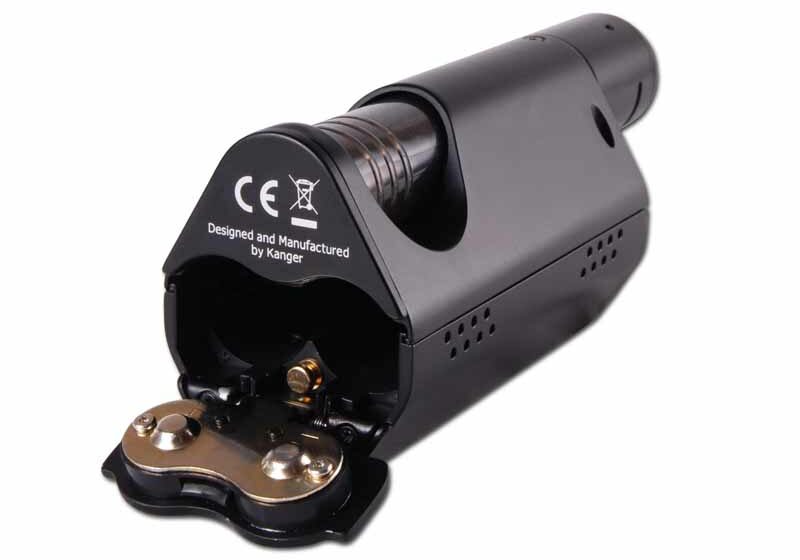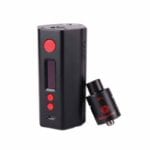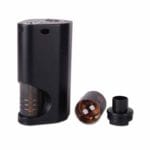Squonk story

The Kanger Dripbox 160
By Mike Huml
Right on the heels of Kanger’s original Dripbox kit comes the new Dripbox 160. It’s a 160-watt variable device with a squonk design, previously known as a “bottom feeder” design. The premise here is that instead of an RDA being drip-fed from the top, a bottle housed within the mod is squeezed and liquid flows from the bottom through the hollow positive pin. It’s a historically niche design that Kanger has made available to a larger market. It’s a viable alternative to a significantly more expensive squonk mod, but don’t forget the old saying: “You get what you pay for.”
Like other Kanger products, Dripbox is the designation referring to the kit as a whole, which comprises the Dripmod 160 and the Subdrip 160 RDA. Aesthetically, these paired together resemble the Wismec Reuleaux, with Kanger obviously trying to play to that market. In place of a third battery, the Dripmod features a 70 mL soft plastic bottle. As a result, the Dripmod will have a similar ergonomic sensation to the Reuleaux, albeit with shorter battery life and a lower maximum power. In addition, those accustomed to the Reuleaux may need to adjust how they hold the Dripbox due to the fact that the 510 connection is on the opposite side of the fire button. It’s a small inconvenience, but the end result is that many users may not find the Dripbox quite as comfortable to hold as the Reuleaux.
The Subdrip 160 RDA is a fairly standard RDA with one unique feature: The entire deck can be unscrewed and replaced with another pre-made RDA deck. This is a great way to introduce dripping (arguably the most versatile and satisfying way to vape) to the greater market. The option remains to rebuild if so desired, but several different replacement decks are available. While not perfectly built compared to what even an intermediate builder could accomplish, they do the trick and offer an experience far superior to any sub-ohm tank on the market. That aside, the Subdrip 160 RDA has a medium-wide chuff cap that doubles as the airflow control adjustment, which lends itself well to both direct-lung and mouth-to-lung hitting. It’s a surprisingly good RDA with a smaller than usual Velocity-style deck, and while it serves its purpose well, it won’t impress those with an established RDA collection. At its maximum, the airflow is more open than any sub-ohm tank and will provide a satisfying experience for a wide range of vapers.
The menu and screen are bright and easy to read, but there’s nothing of particular note to write home about. It does its job and is easy to use. The Dripbox as a whole is standard Kanger fare when it comes to build quality—it’s good but not great. The buttons are made of plastic but have a nice click to them when pressed. Compared to the original Dripbox, the Dripbox 160 allows you to adjust your wattage easily with the obligatory plus and minus buttons. That alone should persuade any store owner to immediately replace the older Dripbox with the new iteration. It allows for infinitely more customization options and makes it easier to fine-tune the vape experience. In addition, the Dripmod 160 features temperature control for nickel, titanium, nichrome and stainless steel. Overall, these settings work fine but are not 100 percent accurate. All are capable of resisting burning and dry hits, but the temperature setting needs to be experimented with individually for each wire type. With the intended use being RDAs, temperature control generally isn’t as desirable as it would be with a tank, where wicking properties add another dimension that could contribute to dry hits.
So where does the Dripbox 160 fall a bit short? The leaking potential. With so much going on here, there are several points of potential failure, not to mention that many of these points can result in leaking into the mod itself. On paper, there’s no reason why the Dripmod shouldn’t work with other RDAs with a squonk pin, like the Velocity V2. In reality, the size of the hole in which the liquid is fed with these other RDAs can make all the difference. The Subdrip 160 seems to have a much wider hole than other RDAs, and therefore it works the best because there is little resistance when the bottle is squeezed. For RDAs with a tighter hole and more resistance, it can be difficult to feed liquid fast enough, if at all. In some cases, the pressure needed to feed the juice can cause leakage into the internals of the Dripmod, which can result in all sorts of chaos. It can cause the device to auto-fire, or not power on at all. It might simply be annoying to mop up juice on a regular basis, or it could cause complete device failure. This is the worst type of problem to have: an inconsistent one. If multiple units of the same device all have the same problem, it’s easy to identify and fix. With so many points of failure and unpredictable results, the Dripbox is a wild card.
The moral of the story here is that while the Dripmod works fairly well with the included Subdrip 160 RDA, it’s not to be recommended for use with other RDAs. If the user decides to tempt fate, that’s his or her prerogative. For a business owner, it’s an unnecessary risk, and it should be acknowledged that this limits the versatility of the device. There are two possible scenarios that arise when this problem comes to light. First, there is still the option to use a regular RDA and drip from the top. However, there are far better options if a customer isn’t interested in the bottom-feed usability of the Dripmod. There are dual-battery mods that are smaller and more ergonomic, and there’s the Reuleaux, which offers a more comfortable feel and longer battery life for a similar investment. On the other hand, since the use of another squonk-capable RDA is a huge unknown, customers are virtually stuck with this one setup. The Subdrip can be used on another device, but the hollow positive pin means that liquid will constantly leak out of the 510 connection with nowhere for it to go except all over the mod or into the pin, which could cause a short circuit or device failure. All this leads to the fact that the potential buyer must be interested in the Dripbox setup, and that setup only.
One could do far worse than the Dripbox, but also far better. It’s a familiar tale from Kanger: a great idea in theory but only mediocre in practice. The one standout purpose of the Dripbox is to introduce dripping to those unfamiliar with it in an easy and simple way. Kanger is often forgiven for many missteps in their products, but those missteps can’t always be ignored. A device that could have been extremely versatile with a wide appeal instead falls into the niche market trap. While it may pique the curiosity of many a Kanger aficionado, the potential for a sharp decline in interest is present. With regulation on the horizon, versatility is a stronger selling point than ever, and the Dripbox hamstrings itself by inadvertently limiting its usage possibilities.



